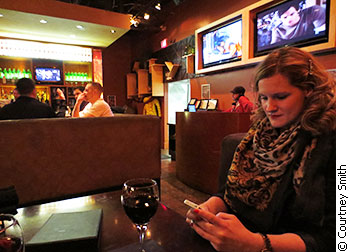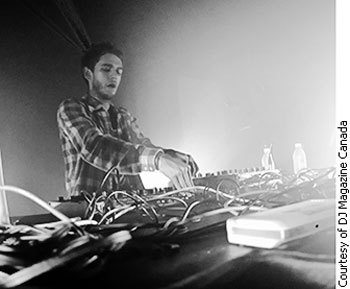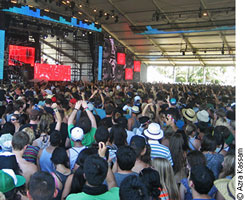Tags
Related Posts
Share This
Eat to the beat
We’ve all seen the images: Teens and young adults, shouting with glee, jump up and down to a beat that an onstage disc-jockey (DJ) mixes for them while strobe lights pulsate across a sea of raised hands. And while we expect to see a DJ at a club or bar, mixing music for partygoers, having a DJ at a restaurant seems like an odd idea. Yet more and more restaurants throughout Ottawa are now bringing in DJs, to guide guests through their meals, one song at a time.

Music is atmosphere. DJ Phil, background right, spins tunes for diners at The Cornerstone Bar and Grill.
For example, Empire Grill, The Cornerstone Bar and Grill and Steak Modern Steakhouse and Lounge are three ByWard Market restaurants that have incorporated DJs into their nighttime atmosphere, creating a subtle interaction between the patrons dining and the music in the background.
“There’s a lot of value to having somebody that’s able to control the emotions of the people around them,” says Robert Hawley, a DJ who plays at various ByWard Market clubs. “Restaurants are starting to realize that, and they don’t want a stagnant, boring playlist.”
An essential part of the craft, according to many DJs, is being able to read the mood of the crowd. Having a live DJ in a restaurant who is playing music based on the desired dining experience creates a certain atmosphere that can encourage people to stay for another drink, increasing the restaurant’s revenue, says Kyle Churchman, bar manager of Empire Grill and a local DJ himself. It’s a way of getting the customer to stay longer, he says.
‘There’s value to having somebody that’s able to control the emotions of the people around them.’ — Local DJ Robert Hawley
“[A restaurant with a live DJ] is the kind of place that is trying to hold their crowd throughout the night,” says 24-year-old Steven Borchuk, who enjoys eating at restaurants with live DJs. “When there’s someone actually there, it’s more conducive to people having a few more cocktails,” he says.
And the restaurant live DJ does more than just improve the spot’s atmosphere and increase the stay-length of guests. He or she is also a way for restaurant owners to enlarge their market by appealing to a younger crowd — a crowd that is more open to the idea of a DJ playing music during dinner, a crowd that is more likely to be out a few nights a week, instead of just one, says Logan Hedmann, manager of Fat Tuesday’s.
“[Restaurant owners] want new blood,” says Hedmann. “They want new potential customers, young customers who are going to keep coming back.”
Mixing it up

DJ Zedd works the controller on stage, mixing beats for crowds at the Ottawa club Liquor Store Party Bar, in October 2012.
Liquor Store Party Bar in the ByWard Market, a combination bar-dancefloor-club that aims primarily at a twenty-something crowd, exemplifies the current, DJ-prone shift in music culture. Recently the club underwent renovations to increase visibility of its new stage and maximize its dance floor capacity. It will be putting in more lights and better sound equipment, allowing it to host shows for well known, international DJs, says general manager Justin Murray.
“We figured there’s no spot downtown that [people] can actually have big [live music] events at,” says Murray. “Our capacity is higher than any other bar in [the ByWard Market], so we figured it would be a good opportunity to open up on off nights, [midweek], for DJ shows.”
Right now, the sound that Liquor Store Party Bar is promoting on DJ nights is Electronic Dance Music (EDM), a popular DJ genre characterized by repetitive beats using synthesizers and heavy bass drops. In the past few years, the increased popularity of EDM has led artists such as Britney Spears and Justin Beiber to incorporate it in their music. (See sidebar: “A Brief History of EDM”.)
From clubs to restaurants
Picking up on the increased demand for DJs by young people has encouraged many restaurants to try and accommodate DJs in their dining atmosphere. “They’re bringing [DJs] into restaurants because [this generation of young people] want to listen to it in restaurants instead of bars and clubs,” says Hedmann.
However, the youthful EDM sound isn’t right for all restaurants, says Liban Hassan, a local DJ who has played at Cornerstone. “When you have a formal restaurant, you shouldn’t be working against its identity.”
A restaurant can be successful with a DJ as part of the ambiance, but if the music doesn’t fit that spot’s atmosphere, it can also lose them customers, says Jamie McConnell, a manager at Steak Modern Steakhouse and Lounge. “When I go to a restaurant, I’m there for good food and booze. I’m not there for the music the DJ is playing,” he says.
But whether playing EDM or classic pop, DJs in restaurants look like they’re currently here to stay.
“You have to give people what they want,” says Hassan. “And people want music.”
A brief history of EDM
Electronic Dance Music (EDM) has been around for more than 30 years, making appearances in the ’80s with songs like “Planet Rock” by DJ Afrika Bambaataa, who incorporated synthesizers in the hip-hop genre tune. In recent years, the public has turned up the sound on this unique genre in international and local music scenes. Ultra Music Festival, an EDM festival held in Miami, saw more than 150,000 people over three days of shows, and Escapade Music Festival, an EDM festival here in Ottawa, had about 15,000 people attend two days of DJ acts.
In this past year alone, digital sales for EDM increased by 42 percent, while album sales rose by 15 percent, according to the International Music Summit 2012 Report. Skrillex, a DJ of the unique sub-genre dubstep, won three Grammy awards and was nominated as “best new artist.”
“EDM itself has grown into a phenomenon: its own genre with its own following,” says Sean Corby, Operations Manager at DNA Presents, an events company in Ottawa that organized Escapade Music Festival.

EDM adore ’em: at the 2012 Coachella Music Festival, Indio, Calif.





